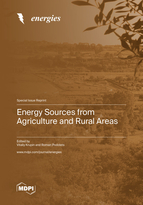Energy Sources from Agriculture and Rural Areas
A special issue of Energies (ISSN 1996-1073). This special issue belongs to the section "L: Energy Sources".
Deadline for manuscript submissions: closed (25 March 2022) | Viewed by 42785
Special Issue Editors
Interests: rural and agricultural development; development policies; rural economy; competitiveness of agriculture; greenhouse gases; international trade
Special Issues, Collections and Topics in MDPI journals
Special Issue Information
This Special Issue is devoted to energy generation within rural areas, including the agricultural sector. Such technologies and application practices vary depending on the type of agricultural activity, local natural conditions, and external factors, thus globally creating a multitude of possible approaches and applications of technologies in particular conditions. We encourage going beyond the strict technological perception and enriching it based on a multidisciplinary approach, making it possible to pursue an understanding of not only energy generation technologies, but also conditions of their implementation and possible measures to increase their efficiency (technological, economic, environmental, and other).
Energy produced within or in addition to agricultural activities supplies the direct needs of farms, as well as other entities through the energy market. Even though it is an integral part of so-called “renewable sources”, agriculture’s distinct features create preconditions and necessity for research on technologies aimed at the generation of energy within agriculture itself. This is needed for both directly addressing such technologies, as well as for substantiation of measures available to ensure the development of complex approaches towards ensuring sustainability in agriculture. It is also crucial considering the policies aimed particularly at the development of agriculture and rural areas (e.g., the EU’s Common Agricultural Policy).
A multitude of economic, social, environmental, and institutional factors constantly modify the conditions for agricultural production, inflicting positive or negative effects upon its structure, output, and efficiency. Climate change issues are forcing agricultural entities to mitigate their negative effect upon the environment, while also creating the necessity to adapt and maintain proper efficiency and output levels. All of these influence the sustainability of rural areas and agriculture, both in terms of its primary production focus, as well as its input into the generation and use of energy.
Dr. Vitaliy Krupin
Dr. Roman Podolets
Guest Editors
Manuscript Submission Information
Manuscripts should be submitted online at www.mdpi.com by registering and logging in to this website. Once you are registered, click here to go to the submission form. Manuscripts can be submitted until the deadline. All submissions that pass pre-check are peer-reviewed. Accepted papers will be published continuously in the journal (as soon as accepted) and will be listed together on the special issue website. Research articles, review articles as well as short communications are invited. For planned papers, a title and short abstract (about 100 words) can be sent to the Editorial Office for announcement on this website.
Submitted manuscripts should not have been published previously, nor be under consideration for publication elsewhere (except conference proceedings papers). All manuscripts are thoroughly refereed through a single-blind peer-review process. A guide for authors and other relevant information for submission of manuscripts is available on the Instructions for Authors page. Energies is an international peer-reviewed open access semimonthly journal published by MDPI.
Please visit the Instructions for Authors page before submitting a manuscript. The Article Processing Charge (APC) for publication in this open access journal is 2600 CHF (Swiss Francs). Submitted papers should be well formatted and use good English. Authors may use MDPI's English editing service prior to publication or during author revisions.
Keywords
- rural areas
- agriculture
- farming
- agricultural energy sources
- bio-energy
- crop production
- energy crops
- biomass
- livestock production
- enteric fermentation
- manure management
- solid biofuels
- liquid biofuels
- biogas
- greenhouse gasses
- sustainable agriculture
- bio-economy







